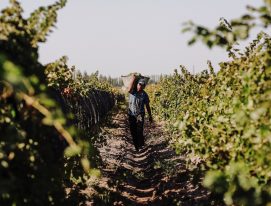Approximately 200 grape varieties are grown in vineyards across Argentina and although international recognition is focused on Malbec, Cabernet Sauvignon, Torrontés and, in recent years, Cabernet Franc, there’s a handful of emerging grapes making a name for themselves with their unique qualities, history and potential. Here, leading professionals on the Argentine wine scene name 5 Argentine wines to look out for in 2025.
5 Argentine wines to discover
Semillón: the revival of a classic white

The first one of the 5 Argentine wines to discover. For a large part of the 20th century, Semillón was Argentina’s favorite white grape. Today, in regions such as the Uco Valley and the Alto Valle del Río Negro, it’s making a comeback with wines that combine freshness, acidity and cellar potential.
Roberto de la Mota, the oenologist at Mendel Wines, describes Semillón from Altamira as “an elegant wine with singular freshness and excellent aging potential thanks to the calcareous soils and the 3400 feet altitude.” This passion is personal to Roberto: “It’s a variety that I made with my father Raúl de la Mota at Bodega Weinert, and I knew it could produce exceptional wines.”
Marcelo Miras, the oenologist and owner at Bodega Miras, believes that the main attraction to consumers is the fact that “it’s a variety that produces very elegant, delicate wines with extraordinary subtlety, wines that evolve extremely well during bottle aging.”
Miras notes that in the Alto Valle del Río Negro they produce wines with a minimum ageing potential of 5 years and, in exceptional years, up to 10.
The floral notes, fruitiness and vibrant acidity are, to Miras, “the distinctive character of Semillón from Alto Valle del Río Negro”.
Chenin blanc: freshness and elegance reborn
The second one of the 5 Argentine wines to discover. Originally from the Loire Valley, Chenin Blanc was popular in the past but output has declined sharply in the face of competition from more popular varieties. Today, it’s being revived in wines that capture its freshness and elegance thanks to old vineyards and visionary winemakers.
Andrea Mufatto, at Michelini i Mufatto, rediscovered a Chenin vineyard in Villa Seca, Uco Valley: “The vineyard was planted in the 70s and has deep, low-yield soils. We were surprised by its freshness, balance and elegance. When it’s young, it’s a very fresh variety but it also has excellent aging potential.”
At Zuccardi Valle de Uco, Laura Principiano is working with a historic vineyard Vista Flores: “Our Chenin has all the purity of the variety. The winemaking process captures the identity of the vineyard and brings out its authenticity.”
In recent years, there has been a clear trend among consumers to seek out new wines and regions, “It’s happening with white wines in general and Chenin is especially lovely,” says Laura.

Syrah: a variety of many faces
The third one of 5 Argentine wines to discover. The Syrah, which is traditionally used for blends, has grown in popularity thanks to its adaptability to different Argentine vineyards, from Medoza to San Juan. The variety has a wide range of profiles, from spicy, fleshy wines to fruity, fresh versions.
It’s certainly found an ideal home in the Cuyo region and especially the Province of San Juan: the way it absorbs and reacts to the local climate and region mean that it presents completely different profiles depending on whether it’s from the Zonda, Calingasta or Pedernal Valleys. The latter terroir is where Felipe Azcona, owner of Elefante Wines, decided to locate his project.
With vines planted over 20 years ago, Azcona thinks that the comeback of the variety “is a little due to the market saturation of Malbec and the fact that there are more educated consumers out there looking for new alternatives.”
Although he thinks that the expression found in Pedernal, with its acidity, juice and character, are “very attractive” to consumers, a key factor in maintaining the resurgence is to maintain “consistent quality in the wines we make.”
Gustavo Rearte, at Achaval Ferrer, works with Syrah in Perdriel and Gualtallary: “In Perdriel, Syrah has elegant notes of a white pepper while in Gualtallary it’s rich and juicy, reflecting the diversity of the variety.”
Sangiovese: Italian heritage in Argentina
The fourth one of the 5 Argentine wines to discover. Brought by Italian immigrants in the 19th century, Sangiovese was for decades one of the most widely-grown varieties in Mendoza. Although it declined a little in the 70s, today it has been reborn thanks to old vineyards and passionate producers.
Federico Isgró at BIRA Wines chooses this variety thanks to its freshness and light body: “Sangiovese produces easygoing wines that are ideal for someone looking for something different.”
Federico Benegas Lynch, who pioneered conservation of the grape in the 2000s, harvests from an over 80 year old vineyard in Cruz de Piedra, Maipú. “Our Sangiovese combines clear fruitiness, a good body and impressive aging potential. It’s a wine that connects the past and the present.”
Tannat: the strength of northern Argentina
Finally, the fifth one of the 5 Argentine wines to discover. Tannat was introduced by European immigrants at the end of the 19th century and has found a special home in the Calchaquí Valleys. With a vibrant, structured character, the variety is earning admirers as a varietal and in blends.
Carla Dal Borgo, from Bodega Dal Borgo, describes Tannat from Salta as “reflecting the landscape with dark fruit and spicy notes. It’s time to banish the myth about it being a coarse, rustic wine.”
Thibaut Delmotte at Bodega Colomé praises the adaptability of the grape planted at 7500 feet. “We’ve achieved intense, fresh wines that are winning people over with their unique character.”
These five Argentine wines show that the diversity of the Argentine wine scene is a long way from being exhausted. Each of them has its own history and distinctiveness and offers a portal into the landscapes and traditions of the country. 2025 will be the perfect year for wine lovers eager to find hidden treasures and to connect with the rich lands of Argentina.



